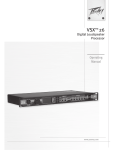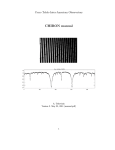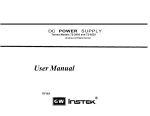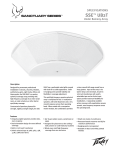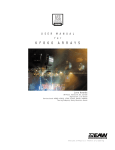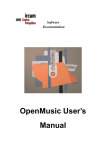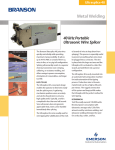Download Peavey Electronics Speaker 48 User's Manual
Transcript
Setting up the Versarray System Processor Settings for Versarray 112Neo & Subs with VSX 26/48 (also Digitool/Prolinx) Single VR112 Neo Cabinet w/118 Sub Front End EQ (before the crossover section) = PEQ –2.0 dB @ 2k, bw= 0.6 (or use 1/3 octave band at 2 kHz set to –2.0 dB); Infrasonic filtering: 24 dB/oct. LR @ 34 Hz) Crossover settings: Woofer= 24 dB/oct. LR @ 2.0 kHz, Tweeter= 24 dB/oct. Bessel @ 3.0 kHz, Woofer Polarity Normal, Tweeter Polarity Normal Sub to Woofer Crossover: Sub= 24 dB/oct. LR @ 125Hz, Woofer= 24 dB/oct LR @ 100Hz, Sub Polarity Normal, Woofer Polarity Normal EQ after crossover: Woofer EQ = PEQ +1.5 dB @ 560 Hz, bw=0.5; PEQ -3.5 dB @ 850 Hz, bw=0.5 PEQ +3dB @ 115 Hz, bw= 2; PEQ –1.5 dB @ 2.2 kHz, bw=.7; PEQ –2 dB @ 700 Hz, bw=3.0 Woofer Delay = 0.0 ms (none) Tweeter EQ: PEQ –3 dB @ 2.7 kHz, bw= 0.7; PEQ +2.5 dB @ 4.6 kHz, bw= 1.0; PEQ +3.5 dB @ 16.5 kHz, bw=1.0 Tweeter Delay = 0.0 ms (none) Sub EQ: PEQ +4.0 dB @ 50 Hz, bw= 0.7; PEQ -2.5 dB @ 100 Hz, bw= 0.5 Chart for Changes with Number of Cabinets No. of Cabs: 1 2 3 4 6 8 218 Sub Level†: 12” Wfr Level: -6.0 dB -2.5 dB -0.5 dB +1.5 dB +4 dB +5.5 dB 0.0 dB 0.0 dB 0.0 dB 0.0 dB 0.0 dB 0.0 dB Twtr 0.0 dB +2.0 dB +4.0 dB +5.5dB +6.5 dB Level: (Drive levels are for factory 16 ohm wiring, for 4 ohm wiring, subtract 6 dB) Front Block EQ‡ at 2 kHz -2.0 dB at 1.8 kHz (at a bw set to 0.577) +7.0 dB - - - - - -3.0 dB -3.5 dB -3.5 dB -4.0 dB bw=.707 -4.5 dB bw=.707 † SPECIAL NOTE: Versarray™ 218 Sub is supplied in 4 ohm mode (woofers paralleled). If the Versarray™ 218 Sub woofers are driven separately, using an amp with the same gain as all the other amps, then drive level to the separate woofers is the same. To convert the above drive levels for a single Versarray™ 218 Sub to drive levels suitable for a single Versarray™ 118 Sub, add 6 dB. When doubling the number of Subs, subtract 6 dB for each time they are doubled. ‡ SPECIAL NOTE: To match this PEQ setting with a 1/3 octave band EQ, use the following: To equate to a PEQ setting of –3 dB @ 1.8k, bw= 0.6 use, 1/3 octave band 2 kHz set to –1.5 dB AND 1/3 octave band 1.6 kHz also set to –1.5 dB To equate to a PEQ setting of –3.5 dB @ 1.8k, bw= 0.6, use 1/3 octave band 2 kHz set to –2 dB AND 1/3 octave band 1.6 kHz set to –1.5 dB To equate to a PEQ setting of –4 dB @ 1.8k, bw= 0.7 (or use 1/3 octave band 2 kHz set to –2.0 dB AND 1/3 octave band 1.6 kHz set to –2.0 dB To equate to a PEQ setting of –4.5 dB @ 1.8k, bw= 0.7 (or use 1/3 octave band 2 kHz set to –2.5 dB AND 1/3 octave band 1.6 kHz set to –2.0 dB Line curvature, or splay between cabinets Splaying the line will tend to require more level increase from the tweeters, and some more cut EQ at 1.8 kHz. A uniform splay of 2.5 degrees between cabinets for an 8 cabinet array would need approximately 2 dB of tweeter boost, and 0.5 dB of 12” woofer level increase, relative to a subwoofer level. A uniform splay of 5 degrees per cabinet for an 8 cabinet array would require approximately 5 dB of tweeter level boost, and approx. 1 dB of 12” woofer level increase, relative to a subwoofer. Complete processor settings for the recommended 2.5 degree continuous curvature with 6 Versarray™ 112 cabinets and one Versarray™ 218 Sub: Front End EQ (before the crossover section) = PEQ –4.0 dB @ 2k, bw= 0.7 (or use 1/3 octave band 2 kHz set to –2.5 dB AND 1/3 octave band 1.6 kHz set to –2 dB) Infrasonic filtering: 24 dB/oct. LR @ 34 Hz) Crossover settings: Woofer= 24 dB/oct. LR @ 2.0 kHz, Tweeter= 24 dB/oct. Bessel @ 3.0 kHz, Woofer Polarity Normal, Tweeter Polarity Normal EQ after crossover: Woofer EQ = PEQ +1.5 dB @ 560 Hz, bw=0.5; PEQ -3.5 dB @ 850 Hz, bw=0.5 PEQ +3dB @ 115 Hz, bw= 2; PEQ –1.5 dB @ 2.2 kHz, bw=.7; PEQ –2 dB @ 700 Hz, bw=3.0 Woofer Delay = 0.0 ms (none) Tweeter EQ: PEQ –3 dB @ 2.7 kHz, bw= 0.7; PEQ +2.5 dB @ 4.6 kHz, bw= 1.0; PEQ +3.5 dB @ 16.5 kHz, bw=1.0 Tweeter Delay = 0.0 ms (none) Sub to Woofer Crossover: Sub= 24 dB/oct. LR @ 125Hz, Woofer= 24 dB/oct LR @ 100Hz, Sub Polarity Normal, Woofer Polarity Normal Sub EQ: PEQ +4.0 dB @ 50 Hz, bw= 0.7; PEQ -2.5 dB @ 100 Hz, bw= 0.5 Level Settings (for same model of power amp, with all channels set to the same voltage gain): One Versarray™ 218 Sub = +4 dB Versarray™ 112: Woofer= 0.0 dB, Tweeter= +8.5 dB (for ribbons wired 16 ohms) SPECIAL NOTE: Versarray™ 218 Sub is in 4 ohm mode (woofers paralleled). If the Versarray™ 218 Sub woofers are driven separately, using an amp with the same gain as all the other amps, then drive level does not increase. A word about system low end The above settings will produce a nominally “flat” system. It is currently fashionable for modern systems to have 6 dB to 15 dB boost in output compared to midband. If this is desired then simply do not cut the drive to the subs and if necessary turn the attenuator clockwise to wide open. If such drastic response is required consider using an “Aux Fed Sub” arrangement. Dynamics settings: The following settings have been chosen to provide a reasonable balance between dynamic range and speaker protection. You may wish to save an additional preset with “safe mode” settings by reducing the threshold by 6 dB. It is often a good idea to start the system up in the safe mode until it is determined that everything is running correctly and the system operator is capable of “safe driving”. The trade off is more protection for less dynamic range. Recommended settings using CS series power amps: Amps w/ att wide open (x40 gain) Ribbons: Threshold, Attack, Release, Gain, –2 dB 5ms – 10 ms 50ms – 100 ms 0 12” woofer: Threshold, Attack, Release, Gain, 4 dB 50ms – 100 ms 500ms – 1000 ms 0 Subs 7 dB 60ms –150 ms 600ms – 1200 ms 0 Threshold, Attack, Release, Gain, Amplifier Level Settings: Sensitivity set at –10 dB is recommended when using Peavey CS series amps. All channels set to the same voltage gain, referenced to the 12” woofer) Crest power amps should be used with the sensitivity setting in the x20 position and the attenuators fully clockwise (wide open) Please review our white paper on minimizing system noise when using VSX on our website VSX presets: A VSX 26 may be used to provide a conventional 2 channel/stereo three way control of any Versarray System. The VSX 48 should be selected when it is desirable to control the system in “zones” that may be used to split coverage between balconies and a main floor or when shading of EQ or Level is desired. The added control provided by the VSX 48 gives the user additional capabilities to fine tune the system. The VSX 48 presets also provide an easy means to use an “aux fed sub” system (see our white paper … http://www.peavey.com/support/technotes/) VSX26 presets: Input A to out 1 – subs out 2 – mids out 3 – highs Input B to out 4 – subs out 5 – mids out 6 – highs VSX 48 presets: Input A Out 1: mids ... top pair Out 2: highs Out 3:mids ... middle pair Out 4:highs Out 5:mids ... bottom pair Out 6:highs Out 7: subs Input B Out 8: subs ... for aux fed subs






